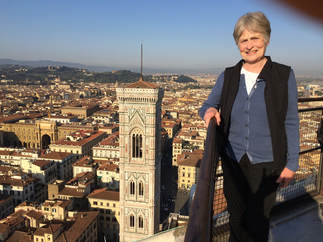
“I go to Florence to write,” I tell people, and that is the truth. For the past ten years I’ve been doing just that in the spring and fall, and last year I fit in a December visit as well.
“I travel alone,” I tell people, and that is also the truth. For the past twenty years I have been doing just that several times a year.
Solitary travel gives me the freedom to make my own schedule, change my plans at whim, live in the moment, and give full attention to my own thoughts, all of which are essential to my writing. If you have a different craft, bring along your paints, clay, needlework, camera, or even your flute. As for me, over the .years I have worked on books for teachers, a memoir, and currently am writing travel articles for this blog.
You, too, can plan a writing vacation in Florence. All you need is a place to stay, the desire to write, and a map to lead you to inviting places for writing: cafes, parks, cloisters, libraries, and tucked away courtyards. You will glean inspiration from the city’s many churches, museums and artisan shops, and from Brunelleschi’s Dome.
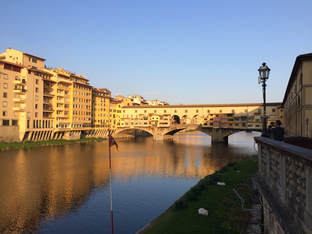
I always rent an apartment because I want space to spread out and relax, and a kitchen.
Apartments are easy to find over the internet. They are less expensive than hotels, and are available for as short a stay as four nights. Each apartment listed gives details of amenities, price, dates of availability, photographs, client comments, and general location.
The photos show the decor and layout of the rooms, and any inviting views from the windows. If no outside pictures are offered, you can be sure the apartment looks out into an alley, or lacks any view worth mentioning. The Duomo and the Arno will always be featured, which is a definite plus for me.
Be sure to read the reviews written by prior renters. I want to know if the apartment is quiet, if it has an elevator (I don’t want to walk up 86 steps), if check-in is easy, and if the internet is reliable. The size of the kitchen and bathroom may also be important to you.
As part of your apartment search you will be asked to indicate which areas of the city you prefer. I keep a street map beside me so I can find the exact location of any apartment that interests me. Since I like to return to my apartment during the day, I choose a section in the historic center. My preference is the Duomo area, because it most centrally located, but I also recommend the areas of Santa Croce, San Lorenzo, and the Arno.
I avoid apartments outside the City Center. They may be less expensive and boast a beautiful terrace, but are probably a long walk or even a bus ride from the City Center, and that is too far for me. I want my apartment to be in the midst of the museums, churches and restaurants that are the landmarks of this culturally rich city.
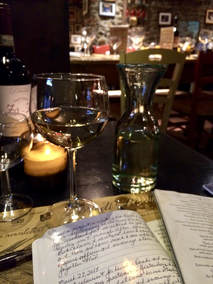
It is said that you can’t get a poor meal in Italy. Whether I prepare a meal in my apartment, or eat at a restaurant, I have found that to be true.
On a given day, especially if it is raining, it feels just right to put my feet up, enjoy a salad or dish of pasta, and write alone at home, which means I have to buy groceries.
Shopping at the Central Market and San Ambrosia, the two biggest markets in Florence, makes me feel I am living in the city. I can wander from stall to stall choosing fresh fruit and vegetables, cheeses, prosciutto, salami, pasta, olives and olive oil, bread, and prepared food. Sometimes I stop for lunch at one of the eating spots nestled among the stalls. If I am at Piazza Santo Spirito. I pick up a head of lettuce from one of the outdoor vendors. Walk along any street and you’ll find shops selling bread, cheese, smoked salmon and prepared lasagna.
There are also many supermarkets throughout the city. Their storefronts blend in with the other shops on the street, so if you are not aware of them, you may pass them by.
Choosing a restaurant is easy. Menus are posted outside every restaurant, so if something appeals to me, in I go. I order vino da cassa, the house wine, which is served by the glass, ¼ or ½ liter, or bottle. Wine in Italy lacks the preservatives we are used to in the states, so enjoy a glass or two without feeling sleepy.
At the bottom of the menu you can note if there is a cover or service charge. In Italy these are considered in lieu of a tip, so when paying the bill, I may leave a little change, and then out I go.
I am always trying restaurants, but I never miss a meal at Ciro and Sons, Via Giglio, 27, behind San Lorenzo near the Medici Chapels. Great hospitality, great food, no matter if I eat inside or out.
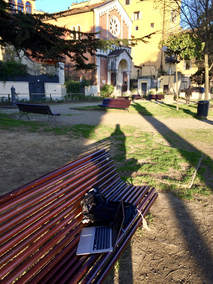
My daily schedule includes walking, sitting in cafes, visiting churches and museums, and eating, with periods of writing interspersed. Nearly all my writing starts in journal form, sometimes handwritten, but often on my MacBook Air, which is light and fits in my backpack; I carry it with me almost all the time. My other valuables, passport, credit cards, cash and Kindle, fit in my Scotty vest of many pockets. My hands are free.
I set my alarm for 6:30 and am out of the apartment by 7, wandering along the Arno and through the back streets, stopping for a quick cappuccino along the way before entering the churches of La Badia, Santa Trinita, or the Duomo (entrance for prayer is through the side door on the south) for twenty minutes of meditation. I need these meditation times because when I walk I think; when I meditate, I empty my mind for new ideas to come. All grist for writing.
Early dinner for me. I am hungry by seven, and being one of the first in the restaurant assures a private table from which I can take my time watching the scene, enjoying the food and wine, reading, and writing in my journal. An after dinner stroll through the Piazza della Signoria to the Arno and the Ponte Vecchio, becomes the other bookend to my early morning walk. My mind begins to empty of daytime chatter, to be filled with a quiet sense of peace as I find my way home for a good night’s sleep. Lights out by 9:30.
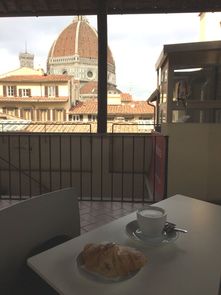
Cafes
My first writing of the day starts with a cappuccino and brioche at a favorite café. I pay at the cashier booth, take the receipt to the bar, and in less than a minute, my cappuccino is ready. Returning to the same cafe morning after morning helps me settle into a writing routine. I feel welcomed as a ‘local’ as I open my computer and pick up where I left off the day before.
Cafe Chiaro Scure is often my first stop because of its extra large coffee cup.
Café Ricchi is my go-to place on a beautiful day when I walk to Piazza di Santo Spirito on the other side of the Arno. I carry my cappuccino and brioche to the room adjacent to the bar, or to a table on the piazza, and begin writing.
Felletrini’s Red Café on the Piazza della Republica is a bookstore cafe. Since it doesn’t open until 9, I often settle in there for my second cappucchino.
These cafes don’t charge extra for sitting in the morning, but check first because in Italy it is often the custom to pay more for that privilege. Once you’ve ordered, however, you can stay all day; there is no pressure to free up the table.Most cafes have free wi-fi and Internet access provided by the municipality of Florence.
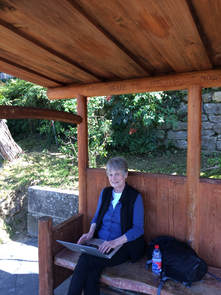 Giardine delle Rose
Giardine delle Rose Florence offers a treasure trove of parks just waiting for you. Pick a destination on your map, or just start walking, and very soon you’ll come to the perfect park bench. Pull out your journal or laptop and start writing.
The Giardine delle Rose, overlooking the city on the way to Piazza Michelangelo, offers many welcoming writing areas. I usually head for a bench in the Japanese Garden, where it is neither noisy nor crowded, just the spot to jot down a few thoughts in my journal or open my computer.
Walk along Via Romana to the spacious public park at the Art School near the Porta Romana, enter the Boboli Gardens at the Pitti Palace, or climb to the Bardini Gardens for an extraordinary view of the Florence. You’ll be glad you have packed a bottle of water, a sandwich, and your computer in your backpack.
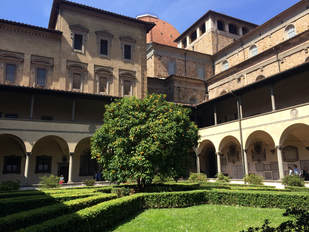 San Lorenzo
San Lorenzo If you want to write outside, rain or shine, a church cloister is a good choice. Although cloisters usually don’t provide benches, I sit on the low wall with my back against a pillar and start writing.
The cloisters adjacent to San Lorenzo, Santa Maria del Carmine, Santa Croce, and Santa Maria Novella are among my favorites.
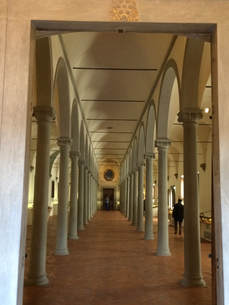 San Marco
San Marco Libraries seem to encourage serious writing: silence is honored, the space is safe, no one pays attention to you, and distractions are at a minimum. I am always inspired when I am among other writers, sharing energy with peers. The two libraries I frequent the most are The Biblioteca delle Oblate, Via dell’Oriuolo, 26, with its quiet writing rooms and café on the portico overlooking Brunelleschi’s Dome, and The Biblioteca Palagio di Parte Guelfa, Piazzetta di Parte Guelfa.
Florence’s historic libraries, may not provide places to write, but they do offer inspiration. The library in the Convent of San Marco, designed by Cosimo de’Medici, is considered to be the first public library in Renaissance Europe. It exhibits fifteenth century manuscripts, along with a display of the writing utensils and raw pigments used to create these manuscripts. The Laurentian Library (adjacent to the Medici church of San Lorenzo) was designed by Michelangelo to house the books and manuscripts belonging to the Medici family.
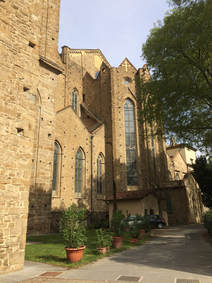 Behind Santa Croce
Behind Santa Croce The city of Florence is a big museum with small museums scattered throughout. Solitary travel heightens my awareness of the inspiration that is presented wherever I go. At a moment’s notice I can turn into the church I am passing, or I can plan ahead to visit the Uffizi. Without the distraction of a traveling companion, I can spontaneously respond to whatever Inspiration appears before me,. Guide books will lead you to the usual attractions, but by wandering about I have found many unique out-of-the-way places that inspire my writing.
Tap into your adventuresome spirit, and discover writing niches wherever you wander. Peer through an open gate and if the prospect looks inviting, find a place to sit, take out your journal or computer and begin.
My special secret place is through the rear entrance of the Scuola del Cuoio (leather school/shop), adjacent to Santa Croce. Park yourself on the steps leading to the apse of the church, or on the shaded stone bench nearby. People may glance at you as they walked by to the shop, but, as in most public places, you will be left alone with your writing.
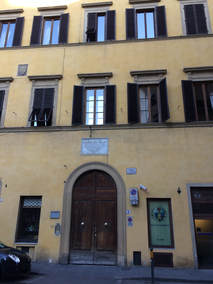 Casa Guida
Casa Guida You can’t miss Dante’s inspiration as you walk around the city. Quotes from his Divine Comedy are incised on plaques hung on buildings throughout the city. The exhibit at Casa Dante brings to life the poet’s work.
Walk through the rooms of Casa Guidi, Piazza San Felice, 8, the home of Elizabeth and Robert Browning from 1847 until 1861, and gaze at Elizabeth and Robert’s writing desks. Also visit the English Cemetery, Piazza Donatello, where Elizabeth is buried.
The creative spirit, be it expressed through writing, painting, sculpture or music, is visible throughout the city. I continue to be inspired by the dedication of street artists and performing musician, and by the craftsmen working away in little shops.
At Lastrucci Mosaics, Via del Macci, 9, watch artists employ original mosaic techniques dating back to the 16th century.
Attend one of the Italian opera concerts Saint Mark’s English Church, Via Maggio, 16, that are offered throughout the year.

Brunelleschi’s Dome has always been my number one inspiration in Florence; it is what draws me back here again and again. Every time I visit I climb the 463 steps to the lantern at the top. I locate my apartment and writing cafes, museums and churches, parks and cloisters, libraries, out of the way places, and all my inspirations. When I come down, I’m ready to write.
 RSS Feed
RSS Feed